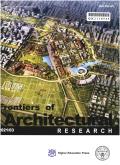基于平歌型地图的中国城市既有历史街道空间尺度效应分析——以泉州东西街为例
IF 3.6
1区 艺术学
0 ARCHITECTURE
引用次数: 0
摘要
针对历史街道空间尺度解释缺乏客观评价标准、纹理碎片化、复杂等问题,提出了一种利用平歌型地图评价历史街道空间尺度效应的分析方法。它借鉴清代(1644-1911)的平歌制图方法,将古代的测量系统与基于物体关系的客观评价标准联系起来,并利用民国(1912-1949)的测绘图来阐明纹理的时间属性。通过典型案例研究,论证了平歌式地图在历史街道解读中的可行性。通过创建泉州古城东西街的平歌式地图,利用形态图,揭示了各地块内的尺度倍增、街道线性序列的变换、地块系列尺度的增减等规律。案例分析表明,平歌式地图有效揭示了中国历史街道布局的空间尺度特征,并可将其转化为维护城市内部秩序的设计资源,从而促进区域建筑集群规划设计中的空间尺度意识。本文章由计算机程序翻译,如有差异,请以英文原文为准。
Spatial scaling effects analysis of existing historical streets in Chinese cities based on the Ping Ge type map—In case study of Quanzhou East‒West Street
In response to the lack of objective evaluation criteria for interpreting the spatial scales of historical streets, as well as the problem of fragmented and complex textures, this research proposes an analysis method for assessing the spatial scaling effects using the Ping Ge type map. Drawing on the Ping Ge cartographic methods from the Qing Dynasty (1644–1911), it connects ancient measurement systems with objective evaluation criteria based on object relations and utilizes surveying maps from the Republic of China (1912–1949) to clarify temporal attributes of texture. The study employs a typical case study to demonstrate the feasibility of using the Ping Ge type map in interpreting historical streets. By creating the Ping Ge type map of the East‒West Street in Quanzhou Ancient City and utilizing form diagrams, it reveals patterns such as scale multiplications within respective plots, transformations in linear sequences of streets, and increases or decreases in plot series scales. The case analysis indicates that the Ping Ge type map effectively uncover the spatial scaling characteristics of historical street layouts in China and can transform them into design resources that preserve the inner order of cities, thereby promoting spatial scaling awareness in the planning and design of regional architectural clusters.
求助全文
通过发布文献求助,成功后即可免费获取论文全文。
去求助
来源期刊

Frontiers of Architectural Research
ARCHITECTURE-
CiteScore
6.20
自引率
2.90%
发文量
430
审稿时长
30 weeks
期刊介绍:
Frontiers of Architectural Research is an international journal that publishes original research papers, review articles, and case studies to promote rapid communication and exchange among scholars, architects, and engineers. This journal introduces and reviews significant and pioneering achievements in the field of architecture research. Subject areas include the primary branches of architecture, such as architectural design and theory, architectural science and technology, urban planning, landscaping architecture, existing building renovation, and architectural heritage conservation. The journal encourages studies based on a rigorous scientific approach and state-of-the-art technology. All published papers reflect original research works and basic theories, models, computing, and design in architecture. High-quality papers addressing the social aspects of architecture are also welcome. This journal is strictly peer-reviewed and accepts only original manuscripts submitted in English.
 求助内容:
求助内容: 应助结果提醒方式:
应助结果提醒方式:


